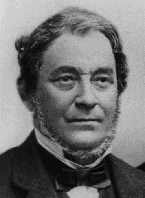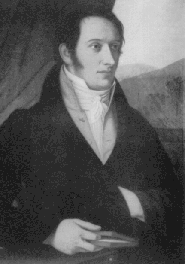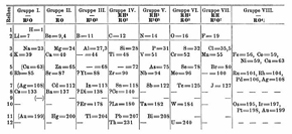Sightseeing with Bunsen
A stroll through the history of chemistry along the Hauptstrasse
Many of Heidelberg´s chemists have not only become part of chemical history but have also left their mark on the city of Heidelberg. The following walk allows all those who are interested to visit these places of interest at a leisurely pace. The best place to start is the Bismarckplatz (see map, BP). Following the outlined route it should take approx. 90 minutes to reach the end of this trip through chemical history at Palais Weimar.

(1) A plaque outside of Hauptstrasse 4 (opposite Kaufhalle) commemorates the private laboratory of August von Kekulé (Bunsen did not allow his Habilitanden[1] to continue their research in his department, thus forcing them to furnish their own laboratories). It was here, between 1856-1858, that Kekule' postulated that carbon possessed a valency of four. Among his friends was Adolf von Baeyer, who did his Ph.D. with Bunsen.
(2) Robert Bunsen had hardly been in Heidelberg for a year, when the work to build the best contemporary chemistry department in Germany was begun. It was to be built on an empty site behind the Haus zum Riesen [House of the Gigant, see (3)], along the Heckenweg (Hedge Lane) which was later to become the Akademiestrasse. 1855 saw the completion of a new building which provided working space for 50 students and functional laboratories for Bunsen´s own research. At the southern end of the building, along the Plöck and opposite the Heckenmarkt (Hedge Market, now Friedrich-Ebert-Platz (FEP)] Bunsen´s private house was built. This also served as accomodation for his successors Victor Meyer and Theodor Curtius.
(3) The place between the Friedrichsbau and the Haus zum Riesen on the opposite side of the Hauptstrasse is centered by a statue of the the great chemist Robert Bunsen who worked in Heidelberg from 1854 to 1899. The statue is flanked by two figures representing the Rivers Rhine and Danube. A memorial plaque outside the "Haus zum Riesen" commemorates the invention of spectral analysis by Bunsen and Gustav Kirchhoff in this building. In the 1860's the Friedrichsbau replaced an earlier Dominican abbey which housed the chemistry department in the days of Leopold Gmelin.
(4) Bunsen, the chemist, Hermann von Helmholtz, a universal genius, and Kirchhoff, the physicist, together with their friend the mathematician Königsberger made Heidelberg an internationally renowned centre of scientific research. The city of Heidelberg honoured these three famous scientists by incorporating their portraits into the facade of the "Stadthalle" (Town hall, SH) which was built at the turn of the 19th century. The stone-carved faces of the three professors look down onto the terrace over the main entrance on the western side of the building. The three reliefs show Hermann v. Helmholtz in the middle, Robert Bunsen to the left and Gustav Kirchhoff to the right.
(5) Just like Kekulé, Emil Erlenmeyer was forced to establish his own laboratory during his Heidelberg time under Bunsen, even though he was a professor here between 1863 and 1867. His laboratory was in Karpfengasse 6, a building still preserved today. He made some major contributions to the understanding of the structure of organic compounds, and first defined carbon double and triple bonds in Heidelberg.
(6) Another student of Erlenmeyer in Heidelberg was Alexander Borodin, later to become professor of chemistry in St. Petersburg. Although he is better known in Germany as a composer than as a chemist, his important contributions to chemistry include the discovery of the aldol reaction and a degradation of carboxylic acids (now known as the Hunsdiecker degradation). He lived in the western corner house, where the Friedrichstrasse meets the Plöck, i.e. right next L. Gmelin´s house.
(7) Leopold Gmelin and his family lived for a long time in a part of the old Dominican abbey [see (3)]. In 1847 he moved into a newly erected house in the Plöck (Plöck 54), opposite Friedrichstrasse, which is marked by a commemorative plaque.
(8) The Russian Dmitri Mendelejew, later to become famous for the periodical system of the elements, lived in Schulgasse 2 (beautiful baroque house with madonna statue to the right of the main entrance of the Jesuitenkirche) during his time as a student of E. Erlenmeyer.
(9) Georg Adolph Succow taught chemistry, physics, biology and mathematics in the "Palais Weimar" (Hauptstrasse 235). His most famous student was Leopold Gmelin who habilitated under his supervision in 1813. The school had, compared to contemporary standards, a well equipped chemical laboratory, which was situated in the western part of the Palais.
(10) You are now standing below Heidelberg Castle which, among other sights, houses the Apothekenmuseum (Pharmacy museum). It displays several items of interest to a chemist, such as a complete baroque chemistry laboratory including an array of glassware, especially distillation apparatus.
(11) Behind the castle, at the prestigious Schloß-Wolfsbrunnenweg, one encounters the Villa Bosch, domicil of the Nobel laureate Carl Bosch (1874-1940). Based on results of Fritz Haber, Bosch developed the industrial synthesis of ammonia (Haber-Bosch process). Juxtaposed to the Villa Bosch is the Carl Bosch Museum Heidelberg ![]() which was established by Gerda Tschira in 1998. The museum presents information on live and work of Carl Bosch and, in addition, highlights scientific life and the chemical industry in the first half of the 20th century.
which was established by Gerda Tschira in 1998. The museum presents information on live and work of Carl Bosch and, in addition, highlights scientific life and the chemical industry in the first half of the 20th century.
[1] The Habilitation is a step in an academic career which is only found in the germanophonic area. To become a professor a suitable candidate, having reached the Ph.D. status, completes a three to five year period of independent research with a professor of his choice. Following an examination he is given his venia legendi allowing him to take up a professorship which will eventually be offered to him by another university . During this step in his career he is referred to as a Habilitand (verb: habilitieren).
Additional Information:
- Prof. Bernthsen: Die Heidelberger chemischen Laboratorien für den Universitätsunterricht in den letzten hundert Jahren (1929)
- Dr. E. von Meyer: Geschichte der Chemie von den ältesten Zeiten bis zur Gegenwart : zugleich Einführung in das Studium der Chemie (1905)
Text: G. Helmchen, W. P. Nolan, T. Stork
(Formatted by P. Hindenberg)


















